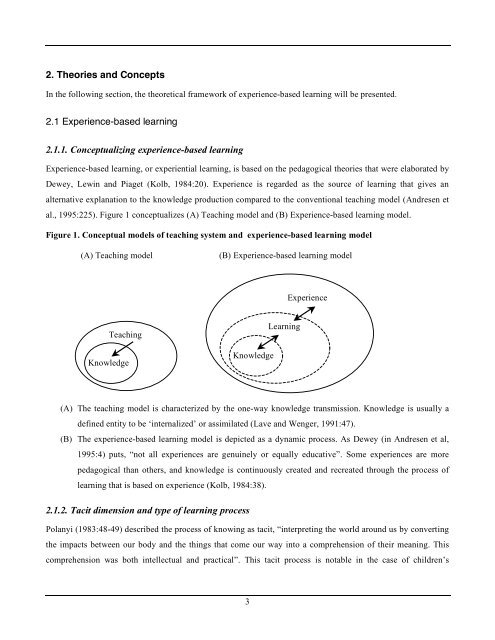Principles and Practices of 4H and Permaculture - lumes
Principles and Practices of 4H and Permaculture - lumes
Principles and Practices of 4H and Permaculture - lumes
Create successful ePaper yourself
Turn your PDF publications into a flip-book with our unique Google optimized e-Paper software.
2. Theories <strong>and</strong> ConceptsIn the following section, the theoretical framework <strong>of</strong> experience-based learning will be presented.2.1 Experience-based learning2.1.1. Conceptualizing experience-based learningExperience-based learning, or experiential learning, is based on the pedagogical theories that were elaborated byDewey, Lewin <strong>and</strong> Piaget (Kolb, 1984:20). Experience is regarded as the source <strong>of</strong> learning that gives analternative explanation to the knowledge production compared to the conventional teaching model (Andresen etal., 1995:225). Figure 1 conceptualizes (A) Teaching model <strong>and</strong> (B) Experience-based learning model.Figure 1. Conceptual models <strong>of</strong> teaching system <strong>and</strong> experience-based learning model(A) Teaching model(B) Experience-based learning modelExperienceTeachingKnowledgeKnowledgeLearning(A) The teaching model is characterized by the one-way knowledge transmission. Knowledge is usually adefined entity to be ‘internalized’ or assimilated (Lave <strong>and</strong> Wenger, 1991:47).(B) The experience-based learning model is depicted as a dynamic process. As Dewey (in Andresen et al,1995:4) puts, “not all experiences are genuinely or equally educative”. Some experiences are morepedagogical than others, <strong>and</strong> knowledge is continuously created <strong>and</strong> recreated through the process <strong>of</strong>learning that is based on experience (Kolb, 1984:38).2.1.2. Tacit dimension <strong>and</strong> type <strong>of</strong> learning processPolanyi (1983:48-49) described the process <strong>of</strong> knowing as tacit, “interpreting the world around us by convertingthe impacts between our body <strong>and</strong> the things that come our way into a comprehension <strong>of</strong> their meaning. Thiscomprehension was both intellectual <strong>and</strong> practical”. This tacit process is notable in the case <strong>of</strong> children’s3
















